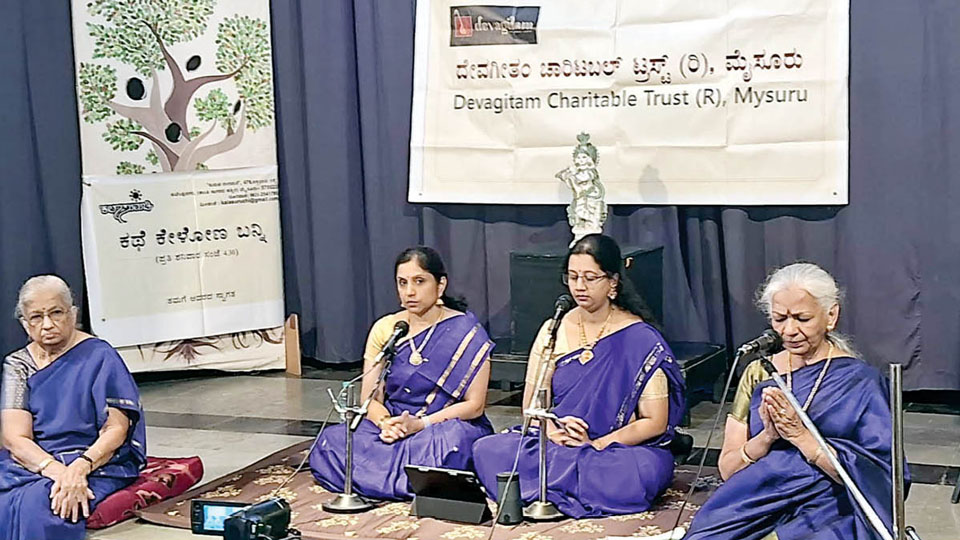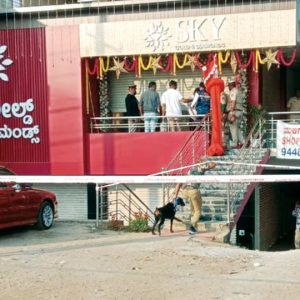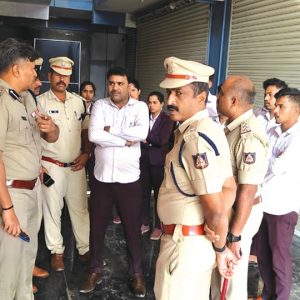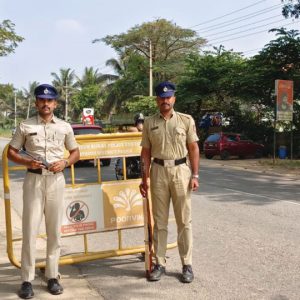Dr. T.S. Satyavathi gave a lecture-demonstration on the life and compositions of Amba Bai on Mar. 31. The programme was organised at Suruchi Rangamane by Devagitam Charitable Trust, Mysuru. Dr. Satyavathi’s students Ashwini Sathish and Lavanya Krishnamurthy accompanied her on the stage.
Haridasa Sahitya has enriched our art and culture to a great extent. Among Haridasas, Amba Bai occupies a special place. During the demonstration, Dr. Satyavathi remembered that Sukanya Prabhakar has done a lot of research work on the women poets and women composers of the past like Helavanakatte Giriyamma, Harapanahalli Bheemavva, etc.
Dr. Satyavathi could get this rare opportunity of knowing about this composer Amba Bai from Dr. Shantha Nagaraj, who is Amba Bai’s niece. Dr. Shantha, who has a doctorate on the subject, was also present at the event.
Amba Bai’s contribution to Haridasa Sahitya is very special and huge as her compositions are rich in lyrical excellence and loaded in devotion. Born in 1902, Amba Bai hails from Chitradurga. Though she joined school and did schooling up to 4th standard, she had to discontinue her formal education as her parents got her married when she was 10 years of age. At twelve, the unfortunate girl lost both her father and husband in plague and the next seventeen years of life were tough on her. She had to live a life full of hardship. At the age of 28, she took ‘Deeksha’ from her Guru Subbaraya Dasa with the signature ‘Muddumohana.’ The next fifteen years saw her active literary life after which Amba Bai left this abode in 1946 at the age of 44.
Till recently Amba Bai’s compositions remained incognito. Renowned Kannada scholar Ananta Padmanabha Rao unearthed Amba Bai’s compositions with Dr. Shantha. Amba Bai has also composed ‘Sri Ramakathamruta Kavya’ containing 2,501 verses in Kusuma Shatpadi. She is undoubtedly the first poetess in Kannada. She had no formal education in music but yet she was a great musician. There are some more works of this great poetess that are yet to come into light.
She got a tamboora as a gift from her Guru. Carrying this tamboora, Amba Bai moved from place to place. There were days when she had to go without food, without sleep.
Amba Bai has composed nearly 400 compositions in a short span of fifteen years which is amazing. Out of these, 102 are on Hari, 12 on Mahalakshmi, one on Ganapati and the list goes on… We see the signature ‘Gopala Krishna Vithala’ in her compositions. Amba Bai’s songs are rich in bhakti and lyrical beauty, wherein she uses metaphors, similes and hypoboles. Some songs are narrative and long while others are short but rich in content. Amba Bai sets an example for women in distress. She is a role model like Akkamahadevi and Meera Bai. She found a path of salvation through her songs.
Dr. Satyavathi gave an elaborate picture of Amba Bai’s life and an analysis of her compositions with illustrations by her students Ashwini and Lavanya. The lyrical excellence of each composition was explained line after line before the girls took it up for singing, which made the audience enjoy each composition thoroughly both lyrically and musically.
The first composition was on Narasimha Swamy in Kedara ‘Udbhavisida kambhadi Sri Narasimha’ set to Mishra gati. Lyrical beauties like Dwiteeyakshara prasa, alliteration, etc. were highlighted. Dr. Satyavathi demonstrated how the raga and the tala were chosen according to the bhava of the lyrics of the song. ‘Ittitta baarendu kareyuvavarilladire vyarthavallave Janmavu’, tuned in Ragesri brought out the pathetic feel. Towards the end, the poetess says she is not a widow anymore as she has Srihari as her husband. ‘Muttaideyade naa muravairi dayadi’ brought joyous mood as the poetess assumes her wedding with the ‘nityatripta’ the Almighty, who is all satisfied.
Amba Bai does not blame others for her fate. In none of the compositions do we see any complaint about life or about society. Though her life was full of distress, the distress itself showed her the path to salvation just as it did to sage Valmiki, who, filled with pathos at the sight of Krouncha being killed in front of his own eyes, spelled out the shloka ‘Ma nishada’ which became a prelude to The Ramayana. ‘Hari Guru Karunadi dorakidudenagee parama pavana Tamburi’ in Hameer Kalyani explained Amba Bai’s joy of reaching the status of being free of this mundane life because of the sacred tamboori offered to her by her Guru.
‘Muru namagala dharisiruva karanaveno?’ brought out the jovial mood as the poetess asks the Lord jovially what how he got the three namas on his forehead, while the song also symbolically depicted Madhwa Siddhanta.
‘Hacchada ogeyabekamma’ tuned by Dr. Satyavathi’s senior disciple Maruti Prasad in Poorvikalyani explains how to wash away our sins. ‘Tunge Mangala tarange,’ one of Amba Bai’s four compositions of our sacred rivers, gives a google map sketch of how Tunge flows from Shivamogga, becomes Tungabhadra with the confluence of Bhadra and then en route Mantralayam finally joins the Bay of Bengal.
The last composition, a mangala kriti, was also special as it can be sung in several nadais. This mangala ‘Mangala pandarivasanige’ in Saurashtra was presented by the girls in four nadais — chaturashra, trishra, khanda and mishra. The entire presentation was highly powerful, informative, moving and elevating. Many in the audience were moved to tears. Kudos to Dr. Satyavathi for this presentation.
—Dr. Padmavathi Narasimhan








Recent Comments